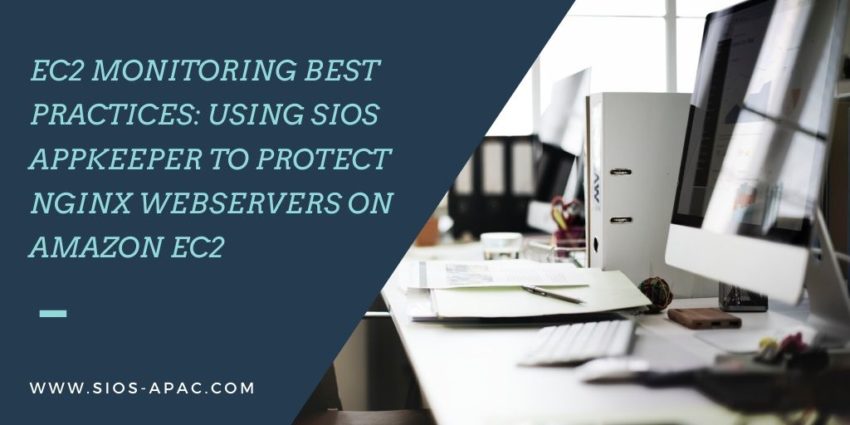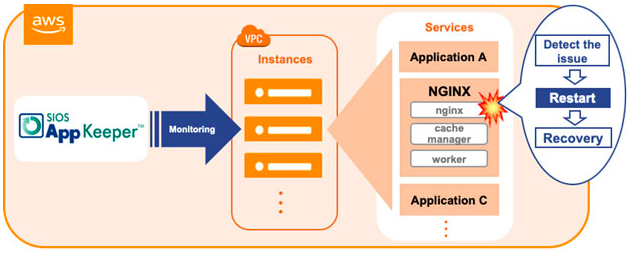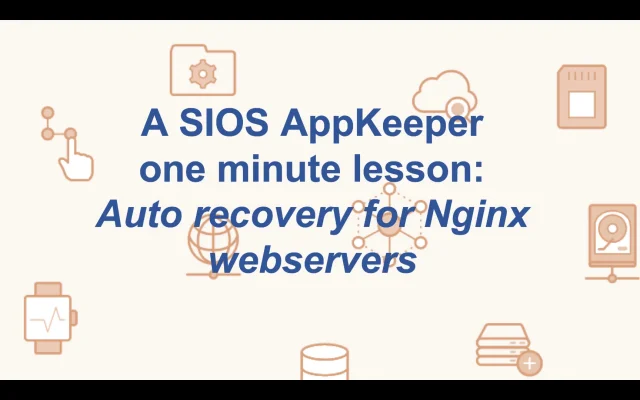 EC2 Monitoring Best Practices: Using SIOS AppKeeper to Protect NGINX Webservers on Amazon EC2
EC2 Monitoring Best Practices: Using SIOS AppKeeper to Protect NGINX Webservers on Amazon EC2
NGINX is a web server that can also act as a load balancer, reverse proxy, etc. Together between them, NGINX and Apache serve more than 50% of the traffic on the web. Today many companies are running their NGINX Open Source or NGINX Plus webservers on the Amazon EC2 environment using either Amazon Linux, Red Hat Linux, and Ubuntu.
Everyone agrees that it is a best practice to monitor applications like NGINX on EC2 and respond to any systems irregularities quickly. Users expect fast access and constant uptime for their applications.
Current choices for monitoring NGINX webservers on Amazon EC2
Many companies are deploying Amazon CloudWatch to monitor their applications, and are even creating some levels of automation by developing scripts or by using AWS Lambda. But configuring Amazon CloudWatch properly with custom metrics and setting up Amazon Lambda requires a certain amount of technical expertise that may be beyond that of many companies. And then there is a cost and effort required to maintain any scripts as the applications evolve.
Another choice is to deploy an application performance monitoring (APM) solution, such as one from New Relic, Dynatrace, Datadog, or LogicMonitor. APM solutions are great. They do a really good job of watching over all your systems and pinpointing what happened and why. They create logs that can be shared with and interpreted by your development team to recreate the issue and ensure that it doesn’t happen again. But here’s the thing: APM solutions provide a lot of data that you have to sort through (separating “signals from the noise”) and they do nothing to recover from failures when they occur. APM tools are only part of the solution when it comes to reducing downtime for your NGINX webservers.
But some companies don’t have the internal staff or tools to monitor their EC2 environment themselves. This is the reason why they choose to outsource the task to a managed service provider. There are some very real benefits to working with an MSP to manage your environment, such as not having to hire more staff as your environment expands, or not having to train your team on new technologies. And the MSPs enjoy efficiencies as they can spread out their investments over many clients. But there are downsides. In some cases, you can be locked into high, fixed-cost contracts, and costs can escalate if issues are experienced and they have to escalate to address them. And you lose continuity between the team that is monitoring the environments and those responsible for building and deploying the applications.
Whether you chose to invest in an APM solution or to outsource to an MSP, you still need to think about how quickly you can recover your NGINX webservers from downtime if and when it occurs. We’d like to propose another alternative: automated remediation with SOIS AppKeeper.
SIOS AppKeeper: Automated remediation for NGINX webservers on EC2
Many of our customers have chosen to use SIOS AppKeeper to protect their NGINX webservers. While they could have chosen a standard application performance monitoring (APM) solution or third-party monitoring solutions, they chose instead to rely on AppKeeper to automatically recover services or the entire EC2 instances if a failure occurs. We will take a look at some of the reasons why and share with you a short video showing how AppKeeper works with NGINX.

SIOS AppKeeper is a SaaS service that is easy to install and configure and monitors any applications running on Amazon EC2, such as your NGINX webservers and their “nginx”, “cache manager”, and “worker” services. When an anomaly is detected, AppKeeper automatically restarts the service, and if that doesn’t work it reboots the entire instance. No more reading through painful logs to pinpoint the reason for the failure, or escalation to developers to restart your service or expensive outsourcing fees. AppKeeper provides “set-it-and-forget-it” functionality so that you can rest assured knowing that your NGINX webservers are following EC2 monitoring best practices and are running properly, or will be quickly restarted if they experience any issues.

Today hundreds of companies rely on AppKeeper to keep their cloud environments running. We invite you to check out this quick video for a demonstration of how AppKeeper protects NGINX webservers.
If you would like to try SIOS AppKeeper for yourself, we offer a 14-day free trial. Simply click here to sign up.